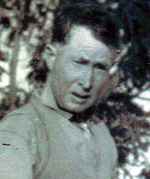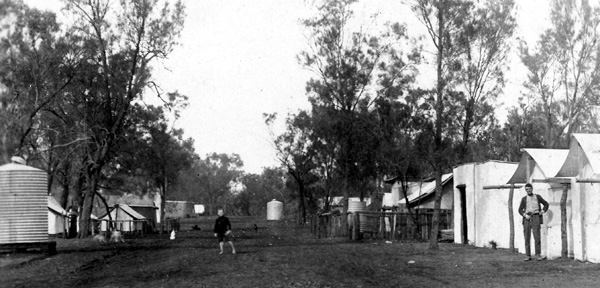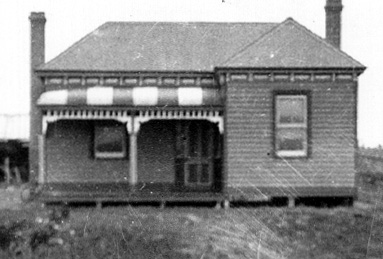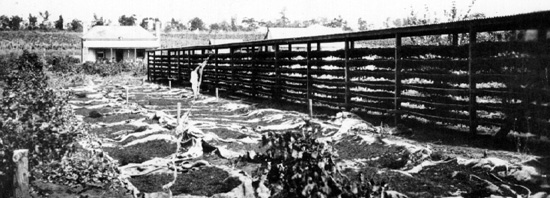
Henry Dadswell (1894-1978), a bush carpenter, returned to Australia from the battlefields of Europe on 5th April 1919 and was discharged by the Australian Army in Melbourne on 2nd July 1919. He had served overseas for 1175 days out of his total of 1386 days as a signaller.
He later successfully applied for land at Red Cliffs in north west Victoria and as a soldier settler spent 50 years growing grapes and other fruit. What follows is a mix of records of conversations and extracts from documents about his early experiences on the land.
After World War One, my sister Ciss [Ethel May Dadswell 1897-1943] and I sold our share of the Warrak farm to our brother Stan [Stanley Alfred Dadswell 1896-1957], and I spent a year on the wheat harvest at Donald. In 1920 I went to Mildura and learned from Ciss and her husband Charles Mitting at Lake Hawthorn about grape growing.
Red Cliffs had barely begun life. In 1922 it had a railway station building that had come from Eversley, and there was a row of tents on the western side of the railway. These were the town's married quarters (postcard picture at right is the early days of Woodbine Avenue, Red Cliffs).
 A second row about 150 yards away was for single men, and there was a large tent which was the eating area.
A second row about 150 yards away was for single men, and there was a large tent which was the eating area.
The train trip in those days used to take 24 hours from Melbourne, with a one hour stop at Donald for meals. I used to get off at St Arnaud with my bike, and ride home to Warrak, near Ararat.
Two small huts, one for Straws Stores and another for Barker and Park, opened on the eastern side of the railway. Game and McNab followed, and then other stores came, built of timber with iron roofs, and there were boarding houses.
I finally got a lease on land in 1922, when wages were three pounds a week. We thought we had won a fortune when our names turned up.
I was staying out at Lake Hawthorn at the time. And then old Wally Friend brought me out on a banana cart, after the harvest was finished at Mittings, and we put a tent up. That was my first place to live at Red Cliffs.
A note in Henry's 1923 diary shows an entry that he was given Block 65a at Red Cliffs East on the 3rd May 1922, and moved onto it about 26th May. The notice of the acceptance of the application for a conditional purchase lease for Block 65a at Red Cliffs was dated 16th August 1922. The 16 acres had a capital value of 400 pounds. Accepting the lease, Henry signed a statement that "I...hereby acknowledge myself a tenant of His Majesty the King (as from and inclusive of the date indicated when the tenancy is expressed to run), in respect of the allotment above referred to as a tenant under Conditional Purchase Lease to be issued to me in due course."
Pretty much all the valley had been cleared for a nursery reserve. It was good land. The property [Block 65a at Red Cliffs East] was mostly cleared when I got it, but there were a few logs and stumps to get out. Trees later grew up again along the roadsides. Other owners had big piles of stumps and mallee roots on their properties which Big Lizzie had pulled out, and they had to gather them up into one corner.
There were mallee roots in places, pine trees (Callitris species) along the ridges and down in the flats, and the heavy ground was all belars (Casuarina or she-oak species). They were a very heavy wood and had to be cut, but it was good burning wood.
While I first started there was still a line of tents on the western side of the railway in Red Cliffs for married quarters and another line for single men. The post office was a little 10 x 12 box over there. Scotty Cooper put up a marquee and used that as an eating place.
One scorching hot day he raced over to Barker and Park's shop, the only store in the town at the time, and asked for paint brushes. When asked what size, he said "the width of a slice of bread, God himself couldn't spread the butter in this weather."
I got a lot of mallee roots for winter fires from Arthur Barber's block next door - he reckoned he had enough to keep him going for 10 years, although I think his lasted only about three.
When I first came out, there were 17 blocks with bachelors on them, with only three or four married couples.
Dad [Alfred Otto Dadswell 1860-1946] came up in 1922 and was going to give me a hand to build a house. But I kept him at work planting up the block and he reckoned later than I never even gave him a day off to have a look at the town or around the district.
He stopped for three or four months, until we got the planting done, and he helped put in the irrigation ditches along the headland. We would mix concrete on the ground, on a board, and then plaster it on the sides of the channel, then put some on the bottom and straighten it all out. We would then put a hole through the sides and put pipes through these.
I had a tent at first, then I put a bag humpy up the back - just poles in the grounds, a tin roof and we had manure bags for the walls. We took the bags down to the river and washed the manure out of them, cut them so they opened right out long-ways, and then sat down and sewed them together until we had enough to go around the humpy. The bags were then whitewashed.
Quite a lot of the women that came up here had to live in places like that for their first 12 months. They had to be tough. The humpies were unlined and had an earth floor.
Then the government gave us 200 pounds to build a house. It covered the cost of two unlined rooms and a chimney. There might have been two small windows in it. And that's all a lot of the women had to start with. And those that were lucky had a stove in it. Mrs Fred Claringbull, talking of when she came up, said she found an "iron contraption" in the chimney which you put wood into one part and cooked in another. She didn't recognise it as a stove!
In 1923 I got approval for the 200 pounds and I drew up plans for a house. I took them into the SR&WSC engineer, Mr S. P. Bromfield, who took a look at it and then tossed them aside. After a while, I asked him if he was going to advance me the 200 pounds.
He said "you're not stupid enough to think you can build a house of that size for 200 pounds are you?" I said I didn't ask him that, but whether he would advance the 200 pounds on those plans. He picked up the plans again and said yes, he would, but he wanted to know what I would do for the rest of the money. I told him that was my business. I also said I happened to be a builder before I came to Red Cliffs, and he said "oh".
 Price and Clark were builders in Red Cliffs and they had a timber yard in Heath Street, near the Presbyterian Church, and I got most of my materials from there.
Price and Clark were builders in Red Cliffs and they had a timber yard in Heath Street, near the Presbyterian Church, and I got most of my materials from there.
And when they pulled the old Mildura Post Office down, Dad went in and bought all the windows, doors and mantle piece. He knew the price of things and he knew what we needed. Dad was very good with timber and he could turn a piece of timber into almost anything. He paid for them, but didn't ask me for the money.
We used red gum for the blocks underneath the house, and the floors were all red pine, as the white ants don't eat them. Dad knew all about it and he refused to have anything except red pine for the floors. The floors (54 years later, in 1977) are still the same timber (original house picture at right).
I thought a cellar would be a good idea to keep things cool in the summer time, but what we didn't know was that this house was built on a seepage patch.(The cellar was never used, as it always had water lying across its floor, and eventually its "trap door" was covered over when linoleum was added to the floor).
I had been told there would be no seepage problems on the block, but within about 12 months some of the vines were starting to sink out, and we had to put in drains. There is a flow of hard rock under the ground, right across the face of the hill. The water gets down to that, banks up, then flows up to the surface and seeps the vines out.
We put a shaft in at the bottom and put the drain across to where the vines were looking sick, and we came across the hard rock underneath. We dug through the sandstone ridge so water would collect into the drains. Finally, we had to put drains in every 8th row right through the block, from bottom to top. It was a lot of extra work we didn't expect.
Drain shafts were sunk down as deep as 50 feet (15 metres) to where there was a solid layer (one foot thick) of sandstone rock. There was sand underneath this layer. I also helped Charlie Richardson (who owned the block opposite, which was later owned by Houldsworths) put his drains in, and almost got caught by bad air when down one of his shafts.
Barbers lived next door, then the famous Monty Williams (he was always moaning and wailing about something, so he got the name 'Prince of Wails'), an Englishman Jack Humphreys who had the end block which later became Bromleys, and Stan Arnold, later owned by Charles.
Over the road, at the end of the valley, was Carter (English), Howard (Australian), Don McDougal (Australian), Bert Newbury (English), Jack McGrath (Australian, his block later became Houldsworths), and Rogers. Charlie Richardson, another English chap, was on the old Houldsworth block.
When I first got the block, Dad gave me a horse, Nugget, to help with the block work.
The surviving page from Henry's diary for 1923 recorded that on Monday, 1st January, he was fishing, an interest which spanned the following 50 years. On Thursday, 4th January, he finished planting cuttings ("Macs" alongside this reference indicates it was probably on the block of Don MacDougal, another of the nearby soldier settlers) and on the next day he sold peas and beans.
Red Cliffs East State School (all five Dadswell children would eventually attend it), opened on the 13th January 1924. The building, which cost 7,304 pounds, was initially for 80 children. (For many years, Henry was a committee member, including committee president, and his wife Jessie was on the mothers club).
At first we used to go down to the nearby Murray River to bathe. Then we would bring water from the river for drinking and washing, but later the irrigation water would give water for the tanks. For lighting we used candles, then later came the hurricane lamps and kero lamps. The Gloria light came later still, and electricity arrived for us in the 1950s.
 I can remember the first dance at Red Cliffs East State School, for the opening in 1924 when 100 men turned up and 6 women. The bulk of us only had a look at the women when they were dancing, we didn't even get near them to ask them for a dance. So we made up 'buck sets' in the square dances.
I can remember the first dance at Red Cliffs East State School, for the opening in 1924 when 100 men turned up and 6 women. The bulk of us only had a look at the women when they were dancing, we didn't even get near them to ask them for a dance. So we made up 'buck sets' in the square dances.
The price of fruit dropped dramatically with the first fruit [in 1924]. With the first crop, sultanas brought in 20 pounds a ton (previously it had been 50 pounds), and for gordos I got 8 pounds a ton. The cost of picking alone was 9 pounds a ton.
Picking of grapes was usually done in February/March, with drying extending into the following months.
(One of the few surviving pages from Henry's early Red Cliffs diaries shows that in 1926, he was still taking dried fruit off the drying racks in early July, at the same time as pruning of the vines for the next year's crop.
The entry for Friday, 16th July 1926, said: Sent in two loads of fruit. Last for season. Other entries for this month included music lessons on the morning of Friday, 9th July (presumably violin lessons), an evening at Cecil Parke's concert (described as very good), helping take fruit off a rack at Charlie Richardson's and a visit from C. Mitting (Ciss) and family with Sid and Col.)
In starting a new settlement, things are always rough and ready, and some of the men did not have much time for ministers of religion. The Rev Norman Fettell came to Red Cliffs, sat on a stump and viewed the church site. The boys held a working bee and erected a small church in one day.
Then the reverend went around to interview the flock. He called on one settler, Noel, who saw him coming and quickly lay down on the blazing hot sand in an empty irrigation ditch. The reverend came up near him, looked around, and then sat on a stump and filled his pipe. After quite a while, he got up, looked around again, and went away.
A week later, Noel was in the town and met the Rev Fettell, who greeted him by saying "I hope your stomach didn't get burned too badly Noel, lying in that hot sand the other day!"
All types of men came to Red Cliffs for the picking season. Pete and his mate arrived and pitched their tent near some bushes. A short distance away was a very rough gang. They were drinking and their language was prime. After midnight, Pete called out "aren't you fellows going to let anyone sleep tonight?" But the men jumped up and the whole gang made for Pete's tent. Pete knew their type and looked around for something to defend himself. He had a black bicycle pump, and it was a clear, moonlit night. The men were close to his tent, telling him what they were going to do, when Pete pushed the pump about three inches out of the tent and said "right, which one of you wants it first?"
There was a startled yell "look out, he's got a gun," and the men fled. There were rattles and bangs as they gathered their gear - and then quiet.
Pete and his mate had dozed off when a light shone on them, and police said "right, hand over your gun." When Pete convinced them it was only a bicycle pump, they laughed and said "better move in the morning, they are a pretty tough bunch and wont be happy to hear they ran away from a bicycle pump."
These Red Cliffs recollections are continued in part 2.
This instalment compiled September 2023 Return to Family Stories Index Page
|

 A second row about 150 yards away was for single men, and there was a large tent which was the eating area.
A second row about 150 yards away was for single men, and there was a large tent which was the eating area. Price and Clark were builders in Red Cliffs and they had a timber yard in Heath Street, near the Presbyterian Church, and I got most of my materials from there.
Price and Clark were builders in Red Cliffs and they had a timber yard in Heath Street, near the Presbyterian Church, and I got most of my materials from there. I can remember the first dance at Red Cliffs East State School, for the opening in 1924 when 100 men turned up and 6 women. The bulk of us only had a look at the women when they were dancing, we didn't even get near them to ask them for a dance. So we made up 'buck sets' in the square dances.
I can remember the first dance at Red Cliffs East State School, for the opening in 1924 when 100 men turned up and 6 women. The bulk of us only had a look at the women when they were dancing, we didn't even get near them to ask them for a dance. So we made up 'buck sets' in the square dances.